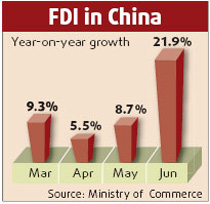The World Tourism Organization has forecast that the Chinese mainland is expected to become the world's second most-popular tourism destination after France by 2010.
Several factors will contribute, including a strong economic backdrop, and further opening of the domestic tourism market to foreign tour operators.
There is also a fast-emerging MICE market (meetings, incentives, conventions and exhibitions) as well as several milestone events like the 2008 Beijing Olympics and 2010 Shanghai World Expo.
Therefore, key gateways such as Shanghai and Beijing continue to be the preferred investment locations for hotels, while investors are also showing interest in hotels in more prominent second-tier cities where opportunities are more available.
The potential gains are considered attractive, says a recently published industry digest by Jones Lang LaSalle Hotels.
Shanghai
Tourism and demand for accommodation in the country's commercial and financial center is expected to grow over the coming years.
Shanghai remains the pilot market on the Chinese mainland for new hotel brands, says the report.
In 2006, JIA boutique hotel launched its outlet on Nanjing Road W. whilst Accor has unveiled a Pudi boutique hotel close to Fuxing Park. Under development are a Conrad and a Jumeirah in Xintiandi.
Drivers for robust accommodation demand include the city's hosting of world-class events such as the Special Olympics, FIFA Women's World Cup in 2007, annual events such as Formula One and in particular, World Expo 2010.
In addition, the development of three major convention areas in Pudong, Hongqiao and Nanjing Road W. as well as new exhibition facilities will further cater to the growing MICE demand. The construction of Shanghai Happy Valley, which is supposed to be the biggest theme park in eastern China, will likely attract about five to seven million visitors every year upon its completion in 2010.
Moreover, upgrades to the city's airports will encourage further growth of inbound arrivals. By next year, Pudong airport will have two terminals and three runways while the expansion of Hongqiao airport features a new 3.3-kilometer runway and a 250,000-square-meter terminal is slated to open by 2010.
In terms of future supply, the Jones Lang LaSalle digest has found that more than 6,982 four- to five-star hotel rooms are under construction and being planned from 2007 onwards.
Significant international projects in the pipeline include the W Hotel Pudong by Starwood, the Wyndham, the HanTang Jumeirah and Conrad hotels, all of which have chosen Shanghai as their launch pad on the Chinese mainland.
Beijing
As one of the largest and fastest-growing cities in the world, tourism and the hotel market are forecast to experience strong growth over the medium to long term.
A favorable economic outlook, a growing MICE market, better infrastructure as well as the city's hosting of the 2008 Olympics will all propel Beijing's tourism and hotel growth, says Jones Lang LaSalle.
Meanwhile, Beijing has been a key entry market for investors keen to ride the growth on the Chinese mainland. The influx of international brands helps further promote the city to the world and potentially increase room rates.
International hotels are expanding their footprint beyond traditional locations within the Central Business District, Wangfujing and the Lufthansa Center.
They are now establishing a presence at Financial Street, Xidan, Zhongguancun, south of Chang'an Avenue, the airport and the new Exhibition Center area in Shunyi to satisfy growing demand.
Moreover, driven by the growth potential of the Beijing hotel market, international operators are putting their flags on properties in multiple locations in the capital city.
For instance, Ritz-Carlton is located at both Financial Street and China Place while Westin is at both Financial Street and the Landmark area.
Beijing Municipal Tourism Bureau announced earlier that the supply of star-rated hotels could increase to 800 properties to accommodate the needs of the 2008 Olympic Games, almost 23 percent more than the current level.
Among the new supply, 76.5 percent, or 9,710 rooms, is expected to enter the market in 2007 and 2008, just in time to capture the Olympic demand.
(Shanghai Daily December 4, 2007)


